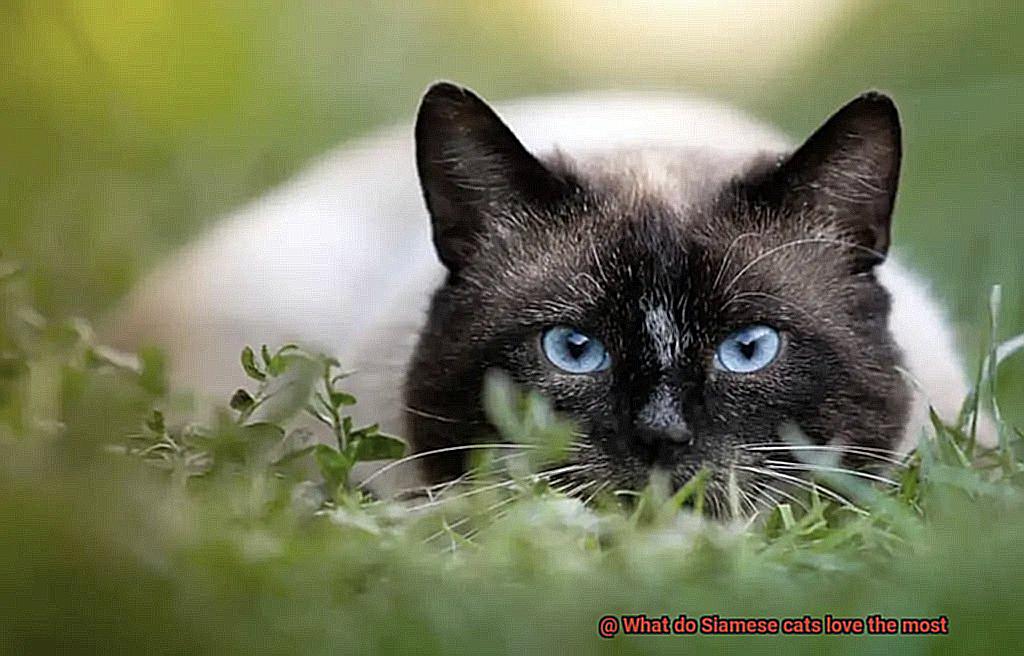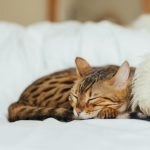Are you a self-proclaimed cat person? If the answer is yes, then you must have experienced the warm embrace of your feline friend at some point in time. The sensation of having a cat snuggle up to you and wrap their paws around your neck is simply heart-melting. But have you ever wondered what it means when your cat hugs you?
Believe it or not, cats are not as indifferent as they are often portrayed. In fact, they are incredibly affectionate creatures that express their love in various ways. One such way is through cuddles and hugs – which can signify different emotions.

In this blog post, we will unravel the mystery behind your kitty’s hugs and cuddles. From adoration to protection and even unease, we will explore the different reasons why cats hug and what your furry companion might be trying to communicate.
As devoted pet parents, understanding your cat’s body language can help solidify your bond with your feline companion. So let’s delve into the enigmatic world of cat hugs and decipher what your kitty is trying to convey.
Understanding Your Cat’s Body Language
As a cat owner, you’ve probably noticed that cats have a unique way of expressing their love and affection. Unlike dogs, cats communicate their emotions through various body language cues, which can be difficult for humans to interpret. However, by understanding your cat’s body language, you can build a stronger bond with your feline friend and provide them with the love and care they deserve.
Head Bumps or Bonks
If your cat approaches you with their tail up, ears forward, and rubs their head against you, it’s a sign that they are happy to see you and want to interact with you. This type of hug is referred to as a “head bump” or “head bonk.” It shows that your cat trusts you and considers you a part of their family. Pay attention to your cat’s body language when they approach you, as it can signify their level of comfort and trust.
Kneading
Kneading is another way cats show affection. This behavior is when your cat pushes their paws in and out against a soft surface, such as a blanket or your lap. Kneading is often associated with feelings of comfort and security, as it mimics the action of kneading milk from their mother while nursing. When your cat kneads on your lap or snuggles up next to you while kneading, it’s a sign that they feel safe and content around you.
Bunting
Bunting is when cats rub their head or cheeks against their owner. This behavior is a way for cats to mark their territory and show affection. By rubbing their scent glands on their owner, cats are essentially claiming them as their own. It’s a sign that your cat loves and trusts you. When your cat bunts against you, it’s essential to reciprocate the affection by petting them or talking to them reassuringly.
The Different Types of Cat Hugs
Understanding the different types of cat hugs can help strengthen the bond between cats and their owners. Here are five sub-sections that explain the different types of cat hugs in detail.

The Head Bump:
The first type of cat hug is the “head bump” or “head bonk.” This is when your cat gently bumps its head against you or an object. It’s a sign of affection and trust, as cats only bump their heads against individuals they feel comfortable with. Your cat may also rub its cheek against you during a head bump, which is a way to mark you as part of their territory.
The Lap Sitter:
The second type of cat hug is the “lap sitter.” This is when your feline friend curls up on your lap or snuggles up next to you. It’s a clear sign of trust, and your cat feels safe and comfortable in your presence. They may even purr while cuddling, which is a sign of contentment and relaxation.
The Wrap-Around:
The third type of cat hug is the “wrap-around” or “full-body” hug. This is when your cat wraps its front paws around your neck or shoulders while standing on its hind legs. This type of hug signifies a strong bond between the two of you and is usually reserved for cats that are very close to their owners.
The Kneading Hug:
The fourth type of cat hug is the “kneading hug.” This is when your cat uses its front paws to knead a soft surface, such as your lap or a blanket. Kneading is a behavior that cats develop as kittens when nursing, and it is a sign of contentment and relaxation. Your cat may also purr during a kneading hug, indicating their happiness and comfort.
The Rubber Hug:
Lastly, there is the “rubber” hug, where your cat rubs its body against your leg or ankle. This is also a sign of affection and a way for your cat to mark you with its scent.
Head Bump or Head Bonk
Your cat comes over to you, gently pressing its forehead against your face or hand, and then takes a step back with a satisfied look on its face. But what’s the significance behind this adorable behavior?
Firstly, head bumping is a way for cats to mark their territory and communicate with their owners. This behavior, also known as bunting, releases pheromones from the scent glands located on their forehead, which helps establish familiarity and comfort with their owner. So, if your cat is head bumping you, they are essentially saying “you belong to me” in their own special way.
Secondly, cats may head bump or head bonk to receive attention or affection from their owner. It’s their way of asking for some cuddles or playtime. They may also greet you with a head bump after being apart for a period of time.
However, it’s important to distinguish head bumping from head pressing, which can be a sign of a medical issue and requires immediate attention from a veterinarian. Head pressing is when a cat repeatedly presses its head against an object or surface for no apparent reason.
Cuddling and Purring
Cats are known for their affectionate nature, and they express their love through cuddling and purring. So, what makes these behaviors so essential for cats?
When a cat cuddles up to you, it is a sign that they feel safe and comfortable around you. It is also an opportunity for them to bond with you and establish trust. Cats crave physical contact and affection from those they love, just like humans do. Cuddling is one of the ways they communicate their feelings towards their owner.
Purring is another way cats show their affection, and it often accompanies cuddling. Purring is a low, rumbling sound that cats make when they are happy and content. Although the reason behind purring is not always clear, experts believe that it is a way for cats to communicate with their owners and other cats.
But that’s not all. When a cat hugs you, it is an indication of their affection and trust in you. However, not all cats enjoy being hugged or carried. Some cats may find it uncomfortable or even stressful, so it’s crucial to pay attention to your cat’s body language and respect their boundaries.
Not All Cats Enjoy Being Hugged
It’s no secret that we love showering our beloved cats with hugs and cuddles. However, not all felines are fond of physical contact, and it’s essential to recognize that they have their own personalities and preferences, just like us humans.
To ensure that you’re providing your cat with the attention they crave without making them uncomfortable, it’s crucial to pay attention to their behavior and body language. If you notice flattened ears, a twitching tail, or struggling movements, it’s a clear sign that your cat is not a fan of the hug. At this point, it’s best to give them some space to avoid stressing them out.
It’s also important to respect your cat’s boundaries and preferences when it comes to physical contact. While some cats enjoy being hugged and cuddled, others may prefer to show their affection in different ways. They may prefer rubbing against your legs or sitting on your lap instead. By taking the time to understand your cat’s needs and desires, you’ll be able to build a stronger bond with them on their terms.
To sum up, not all cats enjoy being hugged, and it’s essential to understand and respect their preferences. By doing so, you can provide them with the love and affection they crave while keeping them happy and stress-free. Here are some tips to keep in mind:
- Pay attention to your cat’s body language and behavior
- Respect their boundaries and preferences when it comes to physical contact
- Understand that cats are independent creatures who may prefer showing affection in other ways
Alternatives to Show Affection
Don’t worry; cats have plenty of other ways to show their affection. Here are some alternative behaviors that your cat may use to express their love.
First up is bunting, a behavior where your cat rubs their body against you as a way to mark their territory and show that they feel safe and comfortable around you. It’s a gentle reminder that they trust and love you. Plus, it’s an excellent opportunity for some bonding time.
Another way cats show affection is through “love bites” or head-butting. Love bites are gentle nibbles that your cat may give you as a sign of trust and comfort. And head-butting is another way that cats express their love, by gently bumping their head against you as a sign of affection. It may seem odd, but it’s a sweet gesture.
Cats also use their vocalizations to show affection. Purring is the most common behavior that cats exhibit when they’re happy and content. They may also meow or chirp when they want attention or when they’re excited to see you. And let’s not forget about kneading. This behavior involves your cat gently pressing their paws on soft surfaces or even on your lap as a way to show affection.
Finally, playing with your cat is another fantastic way to show affection and build a bond. Interactive playtime with toys or laser pointers can be a fun way for both you and your cat to spend time together and strengthen your relationship. Plus, it’s great exercise for them.
Respect Your Cat’s Boundaries
While it’s natural to want to shower them with love and affection, it’s important to remember that cats are independent creatures who value their personal space. Understanding and respecting your cat’s boundaries is crucial to maintaining a strong and healthy relationship with them.
When it comes to physical affection, not all cats are the same. Some may love being hugged and held close, while others may find it stressful or uncomfortable. It’s important to pay attention to your cat’s body language and vocal cues to determine how they feel about physical touch. Signs of discomfort may include flattened ears, dilated pupils, and a tense body.
Respecting your cat’s boundaries when it comes to physical affection is critical for their wellbeing. Forcing hugs on a cat can cause them stress and anxiety, which can lead to negative health effects such as weight loss and decreased immune function, as well as behavioral issues like aggression or litter box problems. Instead, try engaging in activities with your cat that they enjoy, such as playing with toys or grooming them.
Creating a safe and comfortable environment for your cat is also crucial for respecting their boundaries. Providing a designated space for them to retreat when they need alone time can help reduce stress and promote a sense of security. Additionally, keeping their food, water, and litter box in separate areas can prevent territorial issues.
Strengthening the Bond with Your Cat
It’s all about understanding their needs and showing them love and affection in ways they understand. When your cat hugs you, it’s a sign that they trust you and feel comfortable around you. Here are some ways to strengthen the bond with your furry friend:
Playtime is not just fun for your cat but also helps them release pent-up energy and provides an opportunity for you to interact with them. You can use toys like strings, balls, or even laser pointers to stimulate their natural instincts and keep them entertained. Make sure to switch up the toys to keep things interesting.
Grooming is another fantastic way to bond with your cat. Not only does it help maintain their coat, but it also provides an opportunity for physical touch and bonding. Use a soft brush or comb to groom your cat, and make sure to give them plenty of attention and affection during the process. This can be a relaxing activity for both you and your cat.
Quality time together is essential for strengthening your bond with your cat. Whether it’s cuddling on the couch, watching TV, or simply being in the same room as them while you work, spending time with your cat helps them feel loved and secure. Give them plenty of attention, petting, and praise during this time. You can also talk to them in a soothing tone, which they will appreciate.
It’s vital to respect your cat’s boundaries when it comes to physical touch. Some cats love hugs and cuddles, while others prefer space. Pay attention to their body language and vocal cues to determine what kind of physical touch they’re comfortable with. Forcing them into hugs or physical affection they don’t want can cause stress and anxiety leading to negative health effects.
Conclusion
In conclusion, cats are far from the aloof creatures they’re often made out to be. They have a variety of ways to express their love and affection, including cuddles and hugs. By learning to read your cat’s body language, you can understand what your feline friend is trying to communicate.
Head bumps or bonks are a clear sign of happiness and trust, while kneading indicates comfort and security. Bunting is a way for cats to mark their territory while also showing affection. Cuddling and purring are signs that your cat feels safe and content in your company. However, not all cats enjoy being hugged or carried, so it’s essential to respect their boundaries.
Your cat may use other behaviors to express their love, such as bunting, love bites, head-butting, vocalizations like purring and meowing, kneading, and playing with toys.
It’s vital to understand that forcing physical contact on a cat can cause them stress and anxiety leading to negative health effects. Instead of hugging them tightly against their will, engage in activities that they enjoy like playing with toys or grooming them. This will help strengthen the bond between you two.
By paying attention to your cat’s behavior and body language, you’ll be able to build a stronger relationship with them on their terms. Remember that every cat has its own personality and preferences when it comes to physical contact.


